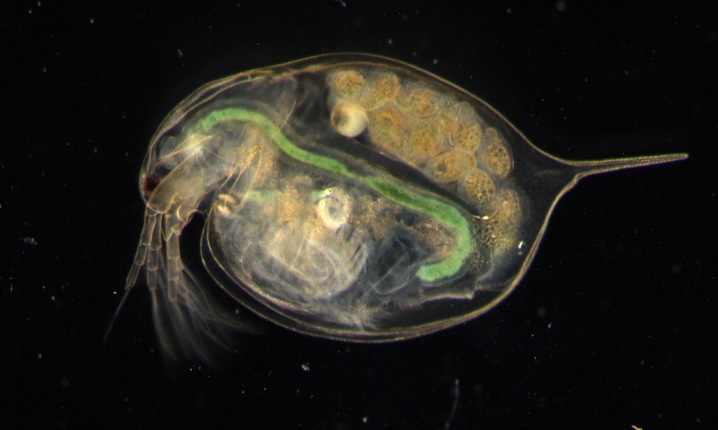Dec 11 2019
As the cut flower industry reaches one of its most active periods, a new study by researchers from RMIT has revealed that the water-absorbing green floral foam used by florists can lead to microplastics-related issues in the world.
 Floral foam inside the digestive tract of a freshwater crustacean. Image Credit: Charlene Trestrail.
Floral foam inside the digestive tract of a freshwater crustacean. Image Credit: Charlene Trestrail.
Researchers discovered from the study reported in Science of the Total Environment that the plastic foam, which disintegrates into very small pieces, is consumed by many marine and freshwater animals, which could eventually lead to health problems in aquatic animals.
According to Charlene Trestrail from the Ecotoxicology Research Group of RMIT, the study that determines the environmental effects of foam for the first time focused particularly on the influence of this extensively used substance on animals living in water.
We tested a range of invertebrates with different feeding modes and all animals ingested the foam, with some species demonstrating stress responses as a result of consuming the material.
Trestrail, PhD Researcher, School of Science, RMIT University
A survey conducted recently by the Sustainable Floristry Network reveals that many florists who use foam discard floral foam particles down the sink.
The survey of over 1,200 florists across the world discovered that two-thirds of florists use foam, and that among them who use, 72% pour the foam wastewater down the sink or drain, whereas 15% introduce it to the soil or garden.
A trend in social media, of crushing floral foam, often directly into the sink, also adds to floral foam pollution problems, with one video promoting the trend acquiring 70 million views. The weight of each foam block is equivalent to the weight of about 10 plastic bags.
According to Rita Feldmann, Founder of the Sustainable Floristry Network, the study confirms the intuitions of concerned florists who question the product and return to more sustainable, traditional floral design methods.
For an industry that seeks to celebrate nature, we are actually adding to environmental problems when using this product. Disposal issues have stemmed directly from a lack of user information about the product on packaging and at the point of sale.
Rita Feldmann, Founder, Sustainable Floristry Network
Feldmann continued, “For the past 60 years, florists all over the world have been pouring it down the sink or putting it in the soil. And we have no idea what customers do with it—we do know that it is regularly buried with coffins.”
Fighting Against Floral Foam
Since 1950s, the floral foam—created by a US manufacturer, Smithers Oasis—has been the base medium of choice for florists across the world.
The study by RMIT researchers demonstrated that the floral foam microplastics also release chemicals that are more toxic than those found in other plastic families into the surrounding water and affect aquatic invertebrates.
According to Trestrail, further research will be required to gain better insights into the effect of the ingestion of particles and associated compounds on animals.
The Sustainable Floristry Network, a new global organization, has been developed as a result of #nofloralfoam movement started by Feldmann, with several florists among the 33,000 following the @nofloralfoam Instagram account.
With the support of eminent florists worldwide, the Sustainable Floristry Network intends to back florists in the direction of more sustainable practices by offering free education on foam-free floristry and sustainable floral design and business practices. This network will also help customers to find a sustainable florist.
The paper titled “Foaming at the mouth: Ingestion of floral foam microplastics by aquatic animals,” with senior authors Professor Dayanthi Nugegoda and Professor Jeff Shimeta, has been published in Science of the Total Environment.